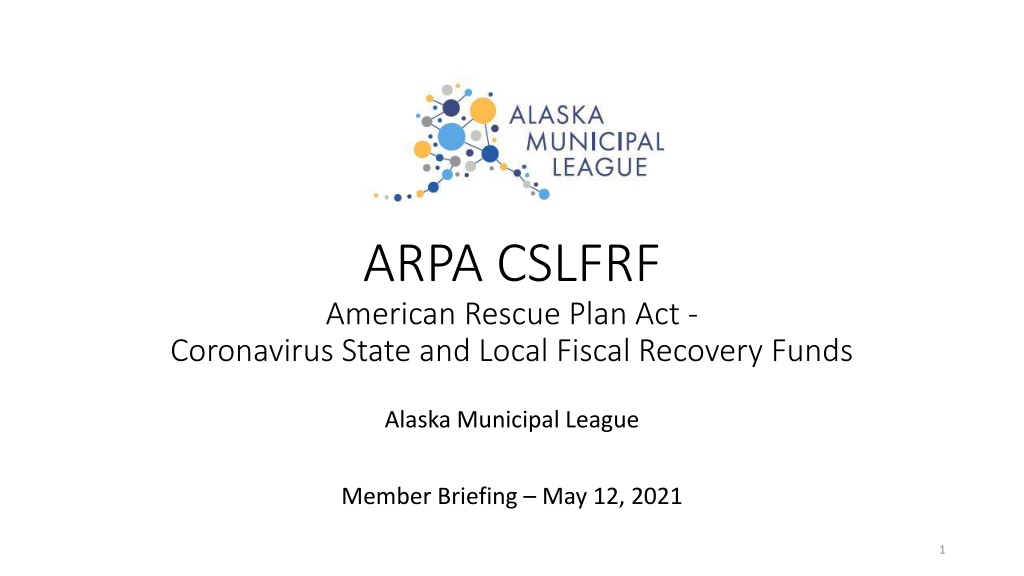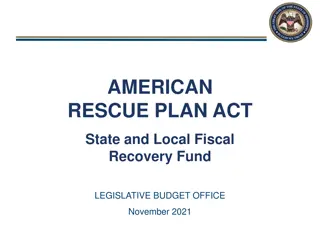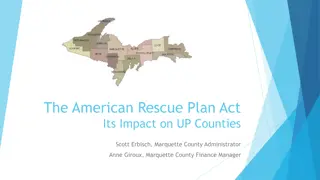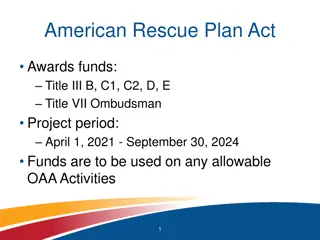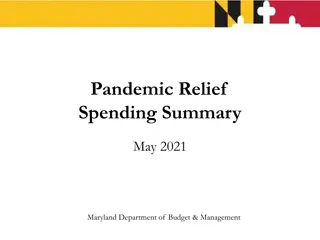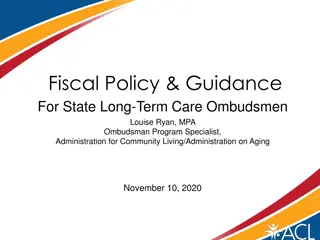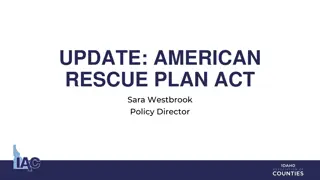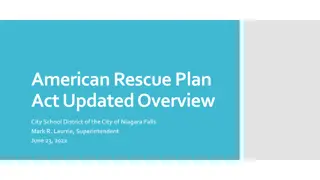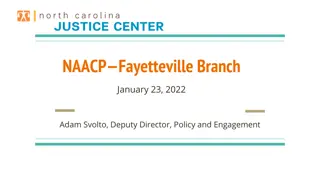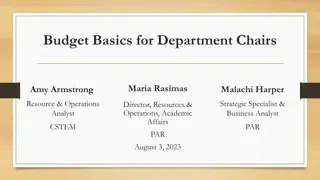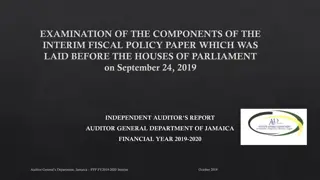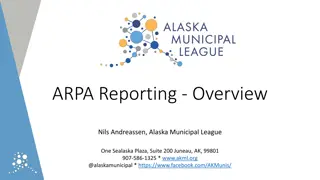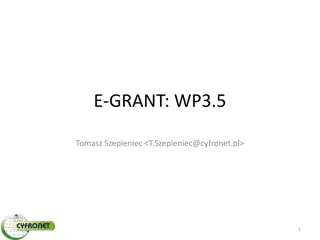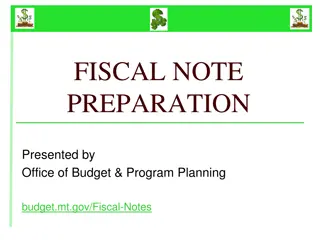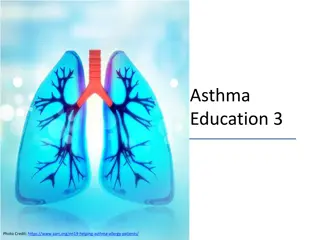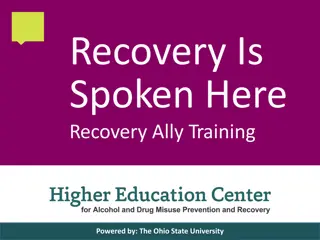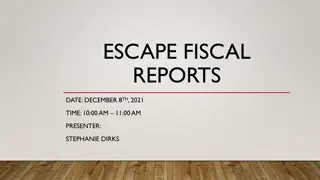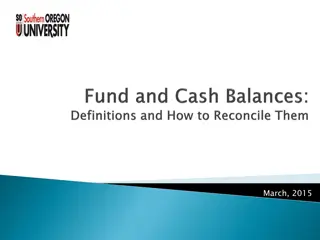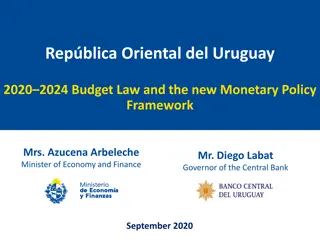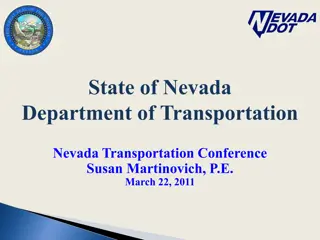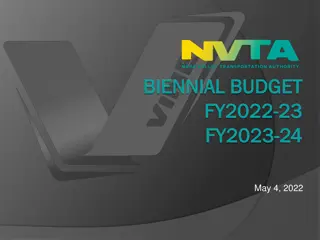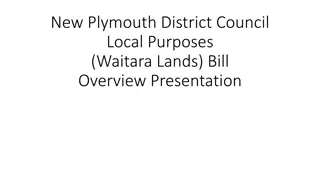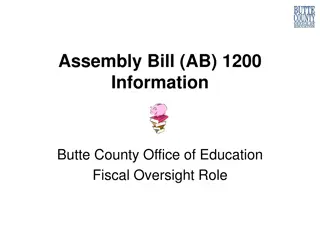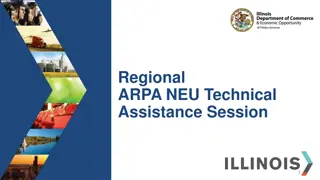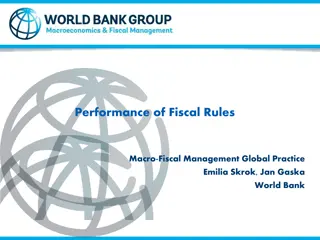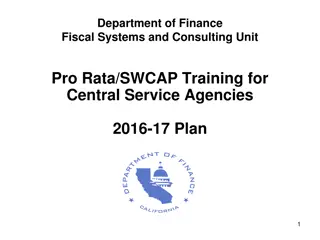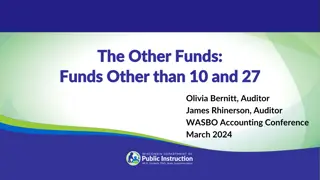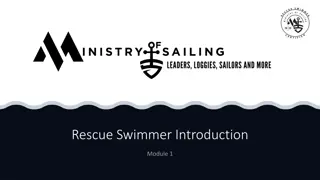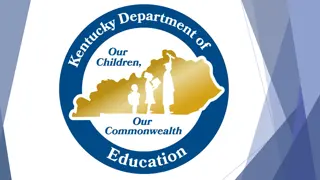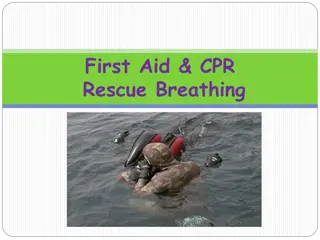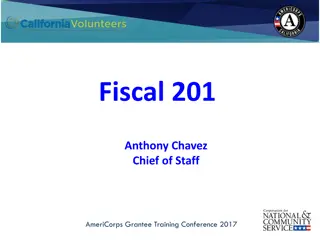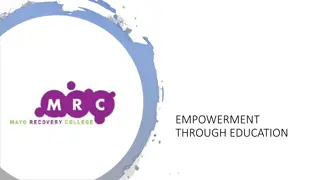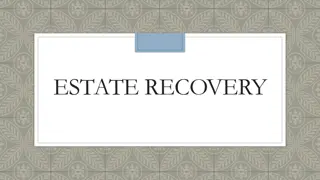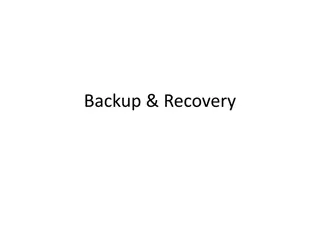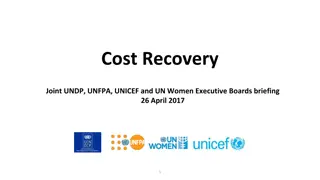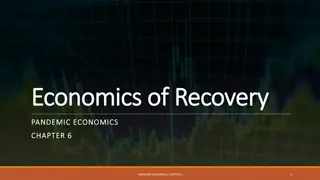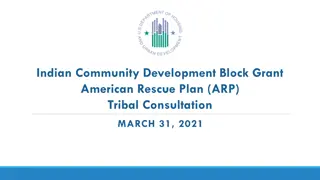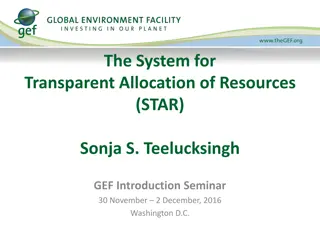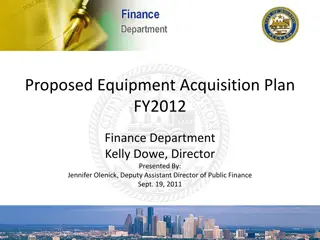American Rescue Plan Act - State and Local Fiscal Recovery Funds Allocation Overview
The American Rescue Plan Act provides funding allocations for various municipalities in Alaska, including boroughs, census areas, and cities. Funds are distributed based on proportional and consistent guidelines with mandatory reporting. The allocation process involves state, boroughs, entitlement cities, non-entitlement cities, and tribes, with specific requirements for accessing and transferring funds outlined by the Treasury.
- American Rescue Plan Act
- State and Local Fiscal Recovery Funds
- Alaska Municipalities
- Fiscal Recovery Allocation
- Treasury Guidelines
Download Presentation

Please find below an Image/Link to download the presentation.
The content on the website is provided AS IS for your information and personal use only. It may not be sold, licensed, or shared on other websites without obtaining consent from the author. Download presentation by click this link. If you encounter any issues during the download, it is possible that the publisher has removed the file from their server.
E N D
Presentation Transcript
ARPA CSLFRF American Rescue Plan Act - Coronavirus State and Local Fiscal Recovery Funds Alaska Municipal League Member Briefing May 12, 2021 1
Treasury Resources Interim final rule Fact sheet FAQs Quick reference guide County Recovery Fund allocations INTERIM FINAL RULE & FAQs Shall = Mandatory Mandatoryreporting, use and compliance May = Allows local/tribal discretion Encourage / Should = Treasury preference only (NOT REQUIRED) 2 Proportional & Consistent
Name Draft Final $ $ 55,940,624.00 $ 3,571,265.00 $ 162,383.00 $ 407,318.00 $ 954,875.00 $ 18,811,783.00 $ 491,423.00 $ 417,224.00 $ 6,210,575.00 $ 11,403,341.00 $ 2,700,106.00 $ 2,524,709.00 $ 1,614,897.00 $ 309,227.00 $ 21,039,307.00 $ 1,943,160.00 $ 1,909,751.00 $ 1,480,290.00 $ 634,382.00 $ 1,204,860.00 $ 1,649,666.00 $ 229,784.00 $ 1,338,884.00 $ 1,787,381.00 $ 485,984.00 $ 112,464.00 $ 1,015,866.00 $ Aleutians East Borough Aleutians West Census Area Anchorage Municipality Bethel Census Area Bristol Bay Borough Denali Borough Dillingham Census Area Fairbanks North Star Borough Haines Borough Hoonah-Angoon Census Area Juneau City and Borough Kenai Peninsula Borough Ketchikan Gateway Borough Kodiak Island Borough Kusilvak Census Area Lake and Peninsula Borough Matanuska-Susitna Borough Nome Census Area North Slope Borough Northwest Arctic Borough Petersburg Borough Prince of Wales-Hyder Census Area Sitka City and Borough Skagway Municipality Southeast Fairbanks Census Area Valdez-Cordova Census Area Wrangell City and Borough Yakutat City and Borough Yukon-Koyukuk Census Area 647,190.60 $ 1,092,679.61 $ 55,855,826.50 $ 3,565,851.48 $ 162,137.05 $ 406,700.24 $ 953,427.93 $ 18,783,267.15 $ 490,677.92 $ 416,591.37 $ 6,201,160.40 $ 11,386,055.08 $ 2,696,013.35 $ 2,520,882.06 $ 1,612,449.10 $ 308,758.60 $ 21,007,415.13 $ 1,940,214.20 $ 1,906,855.85 $ 1,478,046.02 $ 633,420.59 $ 1,203,033.65 $ 1,647,165.05 $ 229,435.57 $ 1,336,854.90 $ 1,784,671.23 $ 485,247.49 $ 112,293.48 $ 1,014,326.29 $ 648,173.00 1,094,338.00 Funding Allocations $1,011,788,220 State of Alaska Boroughs and Census Areas Rough math census cities = $242/pp $142,094,040 Entitlement Cities Anchorage Fairbanks $47,376,742 $5,551,822 Non-entitlement Cities Rough math NEUs = $237/pp $43,189,176 Tribes Base Tribal enrollment + employees $400,000,000+ Any of these may transfer to other units of government, or special units of government 3
Access to Funding State, boroughs, and cities funding in two tranches 50% this year and 50% next Boroughs and Entitlement Cities (Anchorage and Fairbanks); State and Tribes Direct through Treasury at ID.me SSN, DL/Passport, facial recognition Jurisdiction name, taxpayer ID number, DUNS Number, and address Authorized representative name, title, and email Contact person name, title, phone, and email Funds transfer information, including recipient s financial institution, address, phone, and routing number and account number Completed certification document (to be signed by the authorized representative) Treasury Submission Portal- https://api.id.me/en/session/new Census Areas and Non-entitlement cities State accepts on behalf, automatically upon request for State allocation Census areas per capita distribution Must distribute within 30 days of receipt May not add restrictions to access should be similar to above Consolidated governments Eligible for both city and county allocation Tribes Request through Treasury portal; 1st payment is base + pro rata share of enrollment 2nd payment process begins later in May and must be complete by June 7th based on employment numbers Interim Final Rule Section 602 for States and Tribes; Section 603 for local governments 4
Non-Entitlement Units (NEUs) States must make distributions based on population States may not place additional conditions or requirements on distributions to NEUs, beyond those required by ARPA and Treasury States can transfer additional funds to local governments beyond their total allocation Fund transfers have same guidance applied as to States or other governments States required to enforce 75% cap on payments; distributions may not exceed 75% of NEUs most recent budget (as of Jan. 27, 2020). Local government certifies top-line budget total State may use funds to pay for administrative costs of allocating and distributing funds States that have requested their own funds are considered by Treasury to have requested funding for the NEUs as well NEU guidance on distributions and payments to occur in next week 5
Use of Funding Funds may be used to cover costs incurred beginning on March 3, 2021. Funds must be fully obligated by December 31, 2024 Four broad categories of eligibility public health, economic impact, lost revenue, premium pay; plus disproportional impact with QCT and by Tribes Government recipients should be able to support their determination for how the pandemic disproportionately impacted the populations, households, or geographic areas to be served. Use must be tied to impact of public health emergency no general economic or workforce development programs, for example Government recipients should maintain records to support their assessment of how businesses or business districts receiving assistance were affected by the negative economic impacts of the pandemic and how the aid provided responds to these impacts 6
Supporting Public Health Response Among other services, these funds can help support services and programs to contain and mitigate the spread of COVID-19, including: Vaccination programs Medical expenses Testing Contact tracing Isolation or quarantine PPE purchases Support for vulnerable populations to access medical or public health services Public health surveillance (e.g., monitoring for variants) Enforcement of public health orders Public communication efforts Enhancement of healthcare capacity, including alternative care facilities Support for prevention, mitigation, or other services in congregate living facilities and schools Enhancement of public health data systems Capital investments in public facilities to meet pandemic operational needs Ventilation improvements in key settings like healthcare facilities * These and other lists are non-exhaustive. Eligible expenses extend to those that meet the objectives of section 602(c)(1)(A) or 603(c)(1)(A) by responding to the COVID-19 public health emergency with respect to COVID-19 or its negative economic impacts. 8
Supporting Public Health Response Services to address behavioral healthcare needs exacerbated by the pandemic, including: Mental health treatment Substance misuse treatment Other behavioral health services Hotlines or warmlines Crisis intervention Services or outreach to promote access to health and social services Payroll and covered benefits expenses for public health, healthcare, human services, public safety* and similar employees, to the extent that they work on the COVID-19 response. For public health and safety workers, recipients can use these funds to cover the full payroll and covered benefits costs for employees or operating units or divisions primarily dedicated to the COVID-19 response * No longer any presumption of public safety personnel. 9
Address negative economic impacts Delivering assistance to workers and families, including aid to unemployed workers and job training, as well as aid to households facing food, housing, or other financial insecurity. In addition, these funds can support survivor s benefits for family members of COVID-19 victims. Supporting small businesses, helping them to address financial challenges caused by the pandemic and to make investments in COVID-19 prevention and mitigation tactics, as well as to provide technical assistance. To achieve these goals, recipients may employ this funding to execute a broad array of loan, grant, in-kind assistance, and counseling programs to enable small businesses to rebound from the downturn. Speeding the recovery of the tourism, travel, and hospitality sectors, supporting industries that were particularly hard-hit by the COVID-19 emergency and are just now beginning to mend. Similarly impacted sectors within a local area are also eligible for support. Rebuilding public sector capacity, by rehiring public sector staff and replenishing unemployment insurance (UI) trust funds, in each case up to pre-pandemic levels. Recipients may also use this funding to build their internal capacity to successfully implement economic relief programs, with investments in data analysis, targeted outreach, technology infrastructure, and impact evaluations * Cash transfers to individuals/households are eligible and should be reasonable relative to impact of public health emergency and economic impact. 10
Serve hardest hit communities and families Addressing health disparities and the social determinants of health, through funding for community health workers, public benefits navigators, remediation of lead hazards, and community violence intervention programs; Investments in housing and neighborhoods, such as services to address individuals experiencing homelessness, affordable housing development, housing vouchers, and residential counseling and housing navigation assistance to facilitate moves to neighborhoods with high economic opportunity; Addressing educational disparities through new or expanded early learning services, providing additional resources to high-poverty school districts, and offering educational services like tutoring or afterschool programs as well as services to address social, emotional, and mental health needs; and, Promoting healthy childhood environments, including new or expanded high quality childcare, home visiting programs for families with young children, and enhanced services for child welfare- involved families and foster youth. Only if provided within or to families in a Qualified Census Tract, by tribal governments, or to other populations, households, or geographic areas disproportionately impacted by the pandemic 11
Replacing lost public revenue Recipients may use these funds to replace lost revenue, with a methodology that each recipient can use to calculate its reduction in revenue. Recipients will compute the extent of their reduction in revenue by comparing their actual revenue to an alternative representing what could have been expected to occur in the absence of the pandemic. Analysis of this expected trend begins with the last full fiscal year prior to the public health emergency and projects forward at either (a) the recipient s average annual revenue growth over the three full fiscal years prior to the public health emergency or (b) 4.1%, the national average state and local revenue growth rate from 2015-18 (the latest available data). Recipients can presume that any diminution in actual revenue relative to the expected trend is due to the COVID-19 public health emergency. Upon receiving Coronavirus State and Local Fiscal Recovery Funds, recipients may immediately calculate the reduction in revenue that occurred in 2020 and deploy funds to address any shortfall. Recipients will have the opportunity to re-calculate revenue loss at several points through the program, supporting those entities that experience a lagged impact of the crisis on revenues. Importantly, once a shortfall in revenue is identified, recipients will have broad latitude to use this funding to support government services, up to this amount of lost revenue. 12
Lost Revenue General Provisions General Revenue includes revenue from taxes, current charges, and miscellaneous general revenue. It excludes refunds and other correcting transactions, proceeds from issuance of debt or the sale of investments, agency or private trust transactions, and revenue generated by utilities and insurance trusts. General revenue also includes intergovernmental transfers between state and local governments, but excludes intergovernmental transfers from the Federal government, including Federal transfers made via a state to a locality pursuant to the CRF or the Fiscal Recovery Funds. Tribal governments may include all revenue from Tribal enterprises and gaming operations in the definition of General Revenue. Recipients should calculate revenue on an entity-wide basis. That means total revenue loss and not on a source-by-source basis. Beyond tax revenue and government transfers, examples of current charges that would be included in a state or local government s general revenue from own sources: Gross revenue of facilities operated by a government (swimming pools, recreational marinas and piers, golf courses, skating rinks, museums, zoos, etc.); auxiliary facilities in public recreation areas (camping areas, refreshment stands, gift shops, etc.); lease or use fees from stadiums, auditoriums, and community and convention centers; and rentals from concessions at such facilities. 13
Lost Revenue - Calculation Recipients are permitted to calculate the extent of reduction in revenue as of four points in time: December 31, 2020; December 31, 2021; December 31, 2022; and December 31, 2023. Upon receiving Fiscal Recovery Fund payments, recipients may immediately calculate revenue loss for the period ending December 31, 2020. A reduction in a recipient s General Revenue equals: Max {[Base Year Revenue* (1+Growth Adjustment) (n/t/12) ] - Actual General Revenue/t ; 0} Base Year Revenue is General Revenue collected in the most recent full fiscal year prior to the COVD-19 public health emergency. Growth Adjustment is equal to the greater of 4.1 percent (or 0.041) and the recipient s average annual revenue growth over the three full fiscal years prior to the COVID-19 public health emergency. n equals the number of months elapsed from the end of the base year to the calculation date. Actual General Revenue is a recipient s actual general revenue collected during 12-month period ending on each calculation date. Subscript t denotes the calculation date May not use projections, except as allowed by the formula above 3 year average growth rate. 14
Lost Revenue - Use Government services can include, but are not limited to, maintenance of infrastructure or pay-go spending for building new infrastructure, including roads; modernization of cybersecurity, including hardware, software, and protection of critical infrastructure; health services; environmental remediation; school or educational services; and the provision of police, fire, and other public safety services. Paying interest or principal on outstanding debt, replenishing rainy day or other reserve funds, or paying settlements or judgments would not be considered provision of a government service. This restriction on paying interest or principal on any outstanding debt instrument, includes, for example, short-term revenue or tax anticipation notes, or paying fees or issuance costs associated with the issuance of new debt. Exception to eligible use rule on water/sewer, and broadband Use for infrastructure funding allowed to the extent it falls within lost revenue replacement, and the general provision of government services. No need for NEPA if no other federal funds used. 15
Premium pay Recipients may use this funding to provide premium pay directly, or through grants to private employers, to a broad range of essential workers who must be physically present at their jobs including, among others: Staff at nursing homes, hospitals, and home-care settings Workers at farms, food production facilities, grocery stores, and restaurants Janitors and sanitation workers Public health and safety staff Truck drivers, transit staff, and warehouse workers Childcare workers, educators, and school staff Social service and human services staff Treasury s Interim Final Rule emphasizes the need for recipients to prioritize premium pay for lower income workers. Premium pay that would increase a worker s total pay above 150% of the greater of the state or county average annual wage requires specific justification for how it responds to the needs of these workers. May be applied retroactively 16
Water and sewer infrastructure Recipients may use this funding to invest in an array of drinking water infrastructure projects, such as building or upgrading facilities and transmission, distribution, and storage systems, including the replacement of lead service lines. Recipients may also use this funding to invest in wastewater infrastructure projects, including constructing publicly-owned treatment infrastructure, managing and treating stormwater or subsurface drainage water, facilitating water reuse, and securing publicly-owned treatment works. Aligns types of eligible projects with the wide range of projects that can be supported by the Environmental Protection Agency s Clean Water State Revolving Fund and Drinking Water State Revolving Fund. Includes construction of publicly-owned treatment works, nonpoint source pollution management, national estuary program projects, decentralized wastewater treatment systems, stormwater systems, water conservation, efficiency, and reuse measures, watershed pilot projects, energy efficiency measures for publicly-owned treatment works, water reuse projects, security measures at publicly-owned treatment works, and technical assistance to ensure compliance with the Clean Water Act. May not be used as match for CWSRF or DWSRF Costs must be obligated by Dec. 31, 2024, with period of performance through Dec. 31, 2026 17
Broadband Recognizing the acute need in certain communities, Treasury s Interim Final Rule provides that investments in broadband be made in areas that are currently unserved or underserved in other words, lacking a wireline connection that reliably delivers minimum speeds of 25 Mbps download and 3 Mbps upload. Recipients are also encouraged to prioritize projects that achieve last-mile connections to households and businesses. Using these funds, recipients generally should build broadband infrastructure with modern technologies in mind, specifically those projects that deliver services offering reliable 100 Mbps download and 100 Mbps upload speeds, unless impracticable due to topography, geography, or financial cost. In addition, recipients are encouraged to pursue fiber optic investments. In these instances, the affected project would be expected to be designed to deliver, upon project completion, service that reliably meets or exceeds 100 Mbps download and between at least 20 Mbps and 100 Mbps upload speeds and be scalable to a minimum of 100 Mbps symmetrical for download and upload speeds. In view of the wide disparities in broadband access, assistance to households to support internet access or digital literacy is an eligible use to respond to the public health and negative economic impacts of the pandemic, as detailed above. Recipients may also use funds for modernization of cybersecurity, including hardware, software, and protection of critical infrastructure, as part of provision of government services up to the amount of revenue lost due to the public health emergency 18
Ineligible Uses To ensure that these funds are used for their intended purposes, the American Rescue Plan Act also specifies two ineligible uses of funds: States and territories may not use this funding to directly or indirectly offset a reduction in net tax revenue due to a change in law from March 3, 2021 through the last day of the fiscal year in which the funds provided have been spent. No recipient may use this funding to make a deposit to a pension fund. Treasury s Interim Final Rule defines a deposit as an extraordinary contribution to a pension fund for the purpose of reducing an accrued, unfunded liability. While pension deposits are prohibited, recipients may use funds for routine payroll contributions for employees whose wages and salaries are an eligible use of funds. Treasury s Interim Final Rule identifies several other ineligible uses, including funding debt service, legal settlements or judgments, and deposits to rainy day funds or financial reserves. Further, general infrastructure spending is not covered as an eligible use outside of water, sewer, and broadband investments or above the amount allocated under the revenue loss provision. 19
Reporting Financial records and supporting documents related to the award must be retained for a period of five years after all funds have been expended or returned to Treasury, whichever is later. This includes those which demonstrate the award funds were used for eligible purposes in accordance with the ARPA, Treasury s regulations implementing those sections, and Treasury s guidance on eligible uses of funds. Most of the provisions of the Uniform Guidance (2 CFR Part 200) apply to this program, including the Cost Principles and Single Audit Act requirements. Recipients should refer to the Assistance Listing for detail on the specific provisions of the Uniform Guidance that do not apply to this program. The Assistance Listing will be available on beta.SAM.gov 20
Reporting Interim Reports States, territories, metropolitan cities, counties, and Tribal governments will be required to submit one interim report. The interim report will include a recipient s expenditures by category at the summary level and for states, information related to distributions to non-entitlement units of local government must also be included in the interim report. The interim report will cover activity from the date of award to July 31, 2021 and must be submitted to Treasury by August 31, 2021. Nonentitlement units of local government are not required to submit an interim report. 21
Reporting Project and Expenditure Report States, territorial, metropolitan city, county, and Tribal governments will be required to submit quarterly project and expenditure reports. This report will include financial data, information on contracts and subawards over $50,000, types of projects funded, and other information regarding a recipient s utilization of award funds. Reports will be required quarterly with the exception of non-entitlement units, which will report annually. An interim report is due on August 31, 2021. The reports will include the same general data as those submitted by recipients of the Coronavirus Relief Fund, with some modifications to expenditure categories and the addition of data elements related to specific eligible uses. The initial quarterly Project and Expenditure report will cover two calendar quarters from the date of award to September 30, 2021 and must be submitted to Treasury by October 31, 2021. The subsequent quarterly reports will cover one calendar quarter and must be submitted to Treasury within 30 days after the end of each calendar quarter. Non-entitlement units of local government will be required to submit the project and expenditure report annually. The initial annual Project and Expenditure report for non-entitlement units of local government will cover activity from the date of award to September 30, 2021 and must be submitted to Treasury by October 31, 2021. The subsequent annual reports must be submitted to Treasury by October 31 each year. 22
Reporting Performance Report States (defined to include the District of Columbia), territories, metropolitan cities, and counties with a population that exceeds 250,000 residents will also be required to submit an annual recovery plan performance report to Treasury. This report will include descriptions of the projects funded and information on the performance indicators and objectives of each award, helping local residents understand how their governments are using the substantial resources provided by Coronavirus State and Local Fiscal Recovery Funds program. The initial recovery plan performance report will cover activity from date of award to July 31, 2021 and must be submitted to Treasury by August 31, 2021. Thereafter, the recovery plan performance reports will cover a 12-month period and recipients will be required to submit the report to Treasury within 30 days after the end of the 12-month period. The second Recovery Plan Performance report will cover the period from July 1, 2021 to June 30, 2022 and must be submitted to Treasury by July 31, 2022. Each annual recovery plan performance report must be posted on the public-facing website of the recipient. Local governments with fewer than 250,000 residents, Tribal governments, and non-entitlement units of local government are not required to develop a Recovery Plan Performance report. 23
Recoupment Failure to comply with the restrictions on use contained in sections 602(c) and 603(c) of the Act may result in recoupment of funds Review based on quarterly reports; may respond to information provided by members of the public Treasury would notify recipient, who has opportunity to ask for reconsideration. Repayment required within 120 days of the initial notice. 24
Other information May retain assets purchased with FRF; proceeds prior to Dec. 31, 2024 would be subject to restrictions on eligible uses Recipients may use funds to cover the portion of payroll and benefits of employees corresponding to time spent on administrative work necessary due to the COVID 19 public health emergency and its negative economic impacts. This includes, but is not limited to, costs related to disbursing payments of Fiscal Recovery Funds and managing new grant programs established using Fiscal Recovery Funds. An Authorized Representative is an individual with legal authority to bind the government entity (e.g., the Chief Executive Officer of the government entity). An Authorized Representative must sign the Acceptance of Award terms for it to be valid. The verification process takes approximately four business days. Payments are generally scheduled for the next business day after this verification email, though funds may not be available immediately due to processing time of their financial institution. 25
Recipient/Subrecipients Recipient means a State, Territory, Tribal government, metropolitan city, nonentitlement unit of local government, county, or unit of general local government that receives a payment made under section 602(b) or 603(b) of the Social Security Act or transfer pursuant to section 603(c)(4) of the Social Security Act When considering transfers of funds to other units of government, special unit of government, public benefit corporation, or private nonprofit State, local, territorial, and Tribal governments that receive a Federal award directly from a Federal awarding agency, such as Treasury, are recipients. A transferee receiving a transfer from a recipient under sections 602(c)(3) and 603(c)(3) will be a subrecipient. Subrecipients are entities that receive a subaward from a recipient to carry out a program or project on behalf of the recipient with the recipient s Federal award funding. Once Fiscal Recovery Funds are received, the transferee must abide by the restrictions on use applicable to the transferor under the ARPA and other applicable law and program guidance The recipient remains responsible for monitoring and overseeing the subrecipient s use of Fiscal Recovery Funds and other activities related to the award to ensure that the subrecipient complies with the statutory and regulatory requirements and the terms and conditions of the award. Recipients also remain responsible for reporting to Treasury on their subrecipients use of payments from the Fiscal Recovery Funds for the duration of the award. Transfers from local government to the State will not make the State a subrecipient, and Treasury will modify awards upon notification 26
Other Assessing whether a program or service responds to public health emergency Identify a need or negative impact Identify how the program, service, or other intervention addresses that Treasury encourages recipients to provide assistance to those households, businesses, and non- profits in communities most disproportionately impacted by the pandemic. Recipients may use payments from the Fiscal Recovery Funds to facilitate access to resources that improve health outcomes, including services that connect residents with health care resources and public assistance programs and build healthier environments Eligible uses that respond to the negative economic impacts of the public health emergency must be designed to address an economic harm resulting from or exacerbated by the public health emergency Assistance or aid to individuals or businesses that did not experience a negative economic impact from the public health emergency would not be an eligible use under this category A recipient must comply with all other applicable Federal statutes, regulations, and executive orders, and a recipient shall provide for compliance with the American Rescue Plan Act, this Subpart, and any interpretive guidance by other parties in any agreements it enters into with other parties relating to these funds 27
States and Tribes May transfer Fiscal Recovery Funds to other constituent units of government or private entities beyond those specified in the statute State receipt of funds in two tranches, if unemployment not greater than 2% higher than pre- pandemic Replenish State Unemployment Insurance Trust Funds to pre-pandemic balances as of January 27, 2020 For lost revenues, the definition of general revenue would include all revenue from Tribal enterprises, as this revenue is generated from economic activity and is available to fund government services. Prohibits the use of Fiscal Recovery Funds to directly or indirectly offset a reduction in net tax revenue resulting from a change in law, regulation, or administrative interpretation during the covered period Three sources of funds that may offset a reduction in net tax revenue other than Fiscal Recovery Funds organic growth, increases in revenue (e.g., an increase in a tax rate), and certain cuts in spending Payments from the Fiscal Recovery Funds may not be used to satisfy the State share of Medicaid 28
QCT and Tribes Eligible Uses Qualified NM Census Tracts: - Bethel Census - Dillingham Census - Kenai Peninsula Borough - Kusilvak Census - Nome Census - Northwest Arctic Borough - Valdez-Cordova Census - Yukon-Koyukuk Census Services to address homelessness such as supportive housing, and to improve access to stable, affordable housing among unhoused individuals; Affordable housing development to increase supply of affordable and high-quality living units; Housing vouchers, residential counseling, or housing navigation assistance to facilitate household moves to neighborhoods with high levels of economic opportunity and mobility for low-income residents, to help residents increase their economic opportunity and reduce concentrated areas of low economic opportunity. New, expanded, or enhanced early learning services, including pre- kindergarten, Head Start, or partnerships between pre-kindergarten programs and local education authorities, or administration of those services; Providing assistance to high-poverty school districts to advance equitable funding across districts and geographies; Metro Anchorage Mat Su Fairbanks North Star 29
QCT and Tribes Eligible Uses Evidence-based educational services and practices to address the academic needs of students, including tutoring, summer, afterschool, and other extended learning and enrichment programs; Evidence-based practices to address the social, emotional, and mental health needs of students New or expanded high-quality childcare to provide safe and supportive care for children; Home visiting programs to provide structured visits from health, parent educators, and social service professionals to pregnant women or families with young children to offer education and assistance navigating resources for economic support, health needs, or child development; Enhanced services for child welfare-involved families and foster youth to provide support and training on child development, positive parenting, coping skills, or recovery for mental health and substance use challenges 30
Definitions County means a county, parish, or other equivalent county division (as defined by the Census Bureau) Covered benefits include, but are not limited to, the costs of all types of leave (vacation, family- related, sick, military, bereavement, sabbatical, jury duty), employee insurance (health, life, dental, vision), retirement (pensions, 401(k)), unemployment benefit plans (Federal and State), workers compensation insurance, and Federal Insurance Contributions Act taxes (which includes Social Security and Medicare taxes) Covered period means, with respect to a State, Territory, or Tribal government, the period that: (1) Begins on March 3, 2021; and (2) Ends on the last day of the fiscal year of such State, Territory, or Tribal government in which all funds received by the State, Territory, or Tribal government from a payment made under section 602 or 603 of the Social Security Act have been expended or returned to, or recovered by, the Secretary Intergovernmental transfers means money received from other governments, including grants and shared taxes Nonentitlement unit of local government means a city, as that term is defined in section 102(a)(5) of the Housing and Community Development Act of 1974 (42 U.S.C. 5302(a)(5)), that is not a metropolitan city. 31
Definitions Nonprofit means a nonprofit organization that is exempt from Federal income taxation and that is described in section 501(c)(3) of the Internal Revenue Code Reporting year means a single year or partial year within the covered period, aligned to the current fiscal year of the State or Territory during the covered period. Small business means a business concern or other organization that: (1) Has no more than 500 employees, or if applicable, the size standard in number of employees established by the Administrator of the Small Business Administration for the industry in which the business concern or organization operates, and (2) Is a small business concern as defined in section 3 of the Small Business Act (15 U.S.C. 632) Unit of general local government has the meaning given to that term in section 102(a)(1) of the Housing and Community Development Act of 1974 (42 U.S.C. 5302(a)(1)). 32
Definitions Tribal enterprise means a business concern: (1) That is wholly owned by one or more Tribal governments, or by a corporation that is wholly owned by one or more Tribal governments; or (2) That is owned in part by one or more Tribal governments, or by a corporation that is wholly owned by one or more Tribal governments, if all other owners are either United States citizens or small business concerns, as these terms are used and consistent with the definitions in 15 U.S.C. 657a(b)(2)(D) Tribal government means the recognized governing body of any Indian or Alaska Native tribe, band, nation, pueblo, village, community, component band, or component reservation, individually identified (including parenthetically) in the list published on January 29, 2021, pursuant to section 104 of the Federally Recognized Indian Tribe List Act of 1994 (25 U.S.C. 5131) 33
AML will be available to help Access funds through the Treasury Submission Portal Access funds through the State of Alaska Calculate lost revenues Submit annual project and expenditure reports Consult on eligible expenditures Financial tracking and management Liaise with Treasury officials Host of https://alaskaarpa.org/ Contact us at 907-586-1325 or membersupport@akml.org. 34
